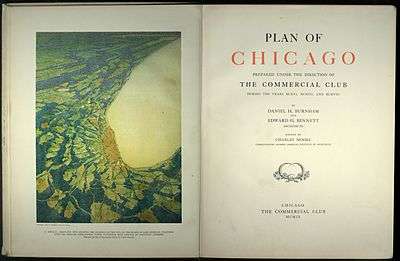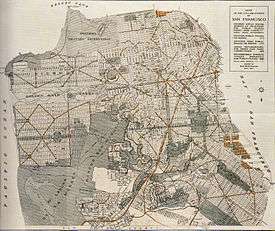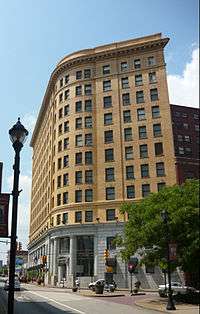Daniel Burnham
| Daniel Burnham | |
|---|---|
 | |
| Born |
September 4, 1846 Henderson, New York, United States |
| Died |
June 1, 1912 (aged 65) Heidelberg, Germany |
| Nationality | American |
| Occupation | Architect |
| Practice | Burnham and Root |
| Buildings | Reliance Building, Flatiron Building, Union Station (Washington, D.C.), Ellicott Square Building |
| Projects |
Plan of Chicago World's Columbian Exposition |


Daniel Hudson Burnham, FAIA (September 4, 1846 – June 1, 1912) was an American architect and urban designer. He was the Director of Works for the World's Columbian Exposition in Chicago.
Burnham took a leading role in the creation of master plans for the development of a number of cities, including Chicago, Manila and downtown Washington, D.C. He also designed several famous buildings, including the Flatiron Building of triangular shape in New York City,[1] Union Station in Washington D.C., the Continental Trust Company Building tower skyscraper in Baltimore (now One South Calvert Building), and a number of notable skyscrapers in Chicago.
Early life
Burnham was born in Henderson, New York and raised in Chicago, Illinois. His parents brought him up under the teachings of the Swedenborgian called The New Church,[2] which ingrained in him the strong belief that man should strive to be of service to others.[3]
After failing admissions tests for both Harvard and Yale, angel and an unsuccessful stint at politics, Burnham apprenticed as a draftsman under William LeBaron Jenney.
Career
At age 26, Burnham moved on to the Chicago offices of Carter, Drake, and Wight, where he met future business partner John Wellborn Root (1850–1891).

Burnham and Root were the architects of one of the first American skyscrapers: the Masonic Temple Building[4] in Chicago. Measuring 21 stories and 302 feet, the temple held claims as the tallest building of its time, but was torn down in 1939. Under the design influence of Root, the firm had produced modern buildings as part of the Chicago School. Following Root’s premature death from pneumonia in 1891, the firm became known as D.H. Burnham & Company.
World's Columbian Exposition
Burnham and Root had accepted responsibility to oversee design and construction of the World's Columbian Exposition in Chicago’s then-desolate Jackson Park on the south lakefront. The largest world's fair to that date (1893), it celebrated the 400-year anniversary of Christopher Columbus' famous voyage. After Root's sudden and unexpected death, a team of distinguished American architects and landscape architects, including Burnham, Frederick Law Olmsted, Charles McKim and Louis Sullivan, radically changed Root's modern and colorful style to a Classical Revival style. Under Burnham's direction, the construction of the Fair overcame huge financial and logistical hurdles, including a worldwide financial panic and an extremely tight timeframe, to open on time.
Considered the first example of a comprehensive planning document in the nation, the fairground was complete with grand boulevards, classical building facades, and lush gardens. Often called the "White City", it popularized neoclassical architecture in a monumental and rational Beaux-Arts plan. The remaining population of architects in the U.S. were soon asked by clients to incorporate similar elements into their designs.
City planning and "The Plan of Chicago"

Initiated in 1906 and published in 1909, Burnham and his co-author Edward H. Bennett prepared "The Plan of Chicago", which laid out plans for the future of the city. It was the first comprehensive plan for the controlled growth of an American city, and an outgrowth of the City Beautiful movement. The plan included ambitious proposals for the lakefront and river and declared that every citizen should be within walking distance of a park. Sponsored by the Commercial Club of Chicago,[5] Burnham donated his services in hopes of furthering his own cause.
Plans and conceptual designs of the south lakefront[6] from the Exposition came in handy, as he envisioned Chicago being a "Paris on the Prairie". French-inspired public works constructions, fountains, and boulevards radiating from a central, domed municipal palace became Chicago's new backdrop. Though only parts of the plan were actually implemented, it set the standard for urban design, anticipating future need to control unexpected urban growth, and continued to influence the development of Chicago long after Burnham's death.
City planning projects did not stop at Chicago though. Burnham contributed to plans for cities such as Cleveland (the Group Plan), San Francisco, and Manila and Baguio in the Philippines, details of which appear in "The Chicago Plan" publication of 1909. His plans for the redesign of San Francisco were delivered to City Hall on April 17, 1906, the day before the 1906 earthquake. In the haste to rebuild the city, the plans were ultimately ignored. The Plan for Manila never fully materialized due to the breaking out of World War II and relocating the capital to another city after the war. Components of the plan which came into fruition include the shore road, which became Dewey boulevard (now known as Roxas boulevard) and various neo-classical government buildings around Luneta Park, which very much resembles a mini version of Washington D.C.
In Washington, D.C., Burnham did much to shape the 1901 McMillan Plan, which led to the completion of the overall design of the National Mall. The Senate Park Commission, or McMillan Commission, established by Michigan Senator James McMillan, brought together Burnham and three of his colleagues from the World's Columbian Exposition—architect Charles Follen McKim, landscape architect Frederick Law Olmsted, Jr., and sculptor Augustus Saint-Gaudens. Going well beyond Pierre L'Enfant's original vision for the city, the plan provided for the extension of the Mall beyond the Washington Monument to a new Lincoln Memorial and a "pantheon" that eventually materialized as the Jefferson Memorial. This plan involved significant reclamation of land from swamp and the Potomac River, and the relocation of an existing railroad station on the site, which was replaced by Burnham's own design for Union Station.[7] As a result of his service on the McMillan Commission, in 1910 Burnham was appointed a member and the first chairman of the United States Commission of Fine Arts, helping to assure the implementation of the McMillann Plan's vision. Burnham served on the commission until his death in 1912.[8]
Influence
Much of his work was based on the classical style of Greece and Rome. In his 1924 autobiography, Louis Sullivan, one of the leading architects from the Chicago School but one who had enjoyed difficult relations with Burnham over an extended period of time, criticised Burnham for what Sullivan viewed as his lack of original expression and dependence on Classicism.[9] Sullivan went on to claim that "the damage wrought by the World's Fair will last for half a century from its date, if not longer"[10]—a sentiment edged with bitterness, as corporate America of the early 20th century had demonstrated a strong preference for Burnham's architectural style over Sullivan's.

Burnham is famously quoted as saying, "Make no little plans. They have no magic to stir men's blood and probably will not themselves be realized." This slogan has been taken to capture the essence of Burnham's spirit.[11][12]
A man of influence, Burnham was considered the preeminent architect in America at the start of the 20th century. He held many positions during his lifetime, including the presidency of the American Institute of Architects.[13] Other notable architects began their careers under his aegis, such as Joseph W. McCarthy.
Death
In 1912, when he died in Heidelberg, Germany, D.H. Burnham and Co. was the world's largest architectural firm. Even legendary architect Frank Lloyd Wright, although strongly critical of Burnham's Beaux Arts European influences still admired him as a man, eulogized: "(Burnham) made masterful use of the methods and men of his time... (as) an enthusiastic promoter of great construction enterprises... his powerful personality was supreme." The successor firm to Burnham's practice was Graham, Anderson, Probst & White, which continued in some form until 2006. Burnham was buried in Graceland Cemetery in Chicago.
Memorials
Tributes to Burnham include Burnham Park and Daniel Burnham Court in Chicago, Burnham Park in Baguio City in the Philippines, Daniel Burnham Court in San Francisco (formerly Hemlock Street between Van Ness Avenue and Franklin Street), the annual Daniel Burnham Award for a Comprehensive Plan (run by the American Planning Association),[14] and the Burnham Memorial Competition held in 2009 to create a memorial to Burnham and his Plan of Chicago.[15] Collections of Burnham's personal and professional papers, photographs, and other archival materials are held by the Ryerson & Burnham Libraries at the Art Institute of Chicago.
Notable commissions
Philippines

- Manila
- Baguio
- Provincial Capitol Building in Bacolod, Negros Occidental
- Pangasinan Provincial Capitol
Chicago
- Union Stock Yard Gate
- Kent House
- Rookery Building
- Butler Brothers Warehouse (Now The Gogo Building)
- Monadnock Building (northern half)
- Reliance Building
- Fisher Building
- Heyworth Building
- Marshall Field and Company Building
- Union Station
- Boyce Building, on the National Register of Historic Places[16][17]
Detroit
Pittsburgh
- Union Trust Building 1898 (337 Fourth Avenue - Not the 1917 structure of the same name on Grant Street)
- Pennsylvania Union Station 1900-1902
- Frick Building 1902
- McCreery Department Store (now offices - 300 Sixth Avenue Building) 1904
- Highland Building 1910 (121 South Highland Avenue)
- Henry W. Oliver Building 1910
Washington, D.C.

Uniontown, Pennsylvania
Cincinnati
- Fourth & Walnut Center
- Union Savings/Bartlett Building [18]
- Tri-State Building [18]
- Fourth National Bank Building[18]
Others
- Flatiron Building, New York City[19][1][upper-alpha 1]
- Citizens Bank Financial Center, Wilkes-Barre, Pennsylvania
- Wyandotte Building, Columbus, Ohio
- Columbus Union Station of 1897
- Gilbert M. Simmons Memorial Library, Kenosha, Wisconsin.
- Ellicott Square Building, Buffalo, New York
- Richmond Railroad Station Historic District Pennsylvania Railroad Station, Richmond, Indiana
- Cleveland Mall with Arnold Brunner and John Carrère, (1903)
- Union Station, El Paso, Texas
- First National Bank Building (now Fayette Building), Uniontown, Pennsylvania, (1902)
- John Wanamaker department store (now Macy's), Philadelphia
- John Wanamaker department store, New York City
- Selfridge & Co. Department Store, Oxford Street, London
- Gimbels Department Store 1910, New York City
- Filene's Department Store 1912, Boston
- Terminal Arcade, Terre Haute, Indiana
- First National Bank Building, Milwaukee, Wisconsin
- Duluth Civic Center Historic District, Duluth, Minnesota
- Merchants Exchange Building (San Francisco)
- The Mills Building 1892. Restoration and expansion 1907-1909(San Francisco)
- Pearsons Hall of Science, Beloit, Wisconsin
- Miners National Bank Building - now Citizens Bank Building, Wilkes-Barre, Pennsylvania
- Land Title Building, Philadelphia, Pennsylvania
- El Granada, CA
- The Fleming Building, Des Moines, Iowa
- Starks Building, Louisville, Kentucky, (1912)
- 100" Telescope, Mount Wilson Observatory, California, (1917)
- Continental Trust Company Building, Baltimore, Maryland, (1901), southeast corner South Calvert and East Baltimore Streets, damaged during Great Baltimore Fire of Feb. 1904, but inspected and steel structure with masonry exterior found sound and later interior reconstructed.
- Union Depot, Keokuk, Iowa (1891)[21]
- Yazoo & Mississippi Valley Railroad station, Vicksburg, Mississippi (1907)[21]
In popular culture
- Make No Little Plans - Daniel Burnham and the American City[22] is the first feature-length documentary film about noted architect and urban planner Daniel Hudson Burnham, produced by the Archimedia Workshop. National distribution in 2009 coincided with the centennial celebration of Daniel Burnham and Edward Bennett's 1909 Plan of Chicago.
- The Devil in the White City, a non-fiction book by Erik Larson, intertwines the true tales of two men: H.H. Holmes, a serial killer famed for his 'murderous hotel' in Chicago, and Daniel Burnham.
- In the role-playing game Unknown Armies, James K. McGowan, the True King of Chicago, quotes Daniel Burnham and regards him as a paragon of the Windy City's mysterious and magical past.
- In the episode "Legendaddy" of TV sitcom How I Met Your Mother, the character Ted, who is professor of architecture, describes Burnham as an "architectural chameleon."
- Burnham is memorialized with the mixed use project in San Francisco, One Daniel Burnham Court.
References
Notes
- ↑ "By 1903, Chicago’s Daniel H. Burnham had completed the twenty-one-story Fuller Building in New York City, which the public quickly redubbed the Flatiron Building because of its iconic triangular plan.[20]
Citations
- 1 2 Laurin, Dale (2008). "Grace and Seriousness in the Flatiron Building and Ourselves" (PDF). Aesthetic Realism Looks at NYC. Aesthetic Realism Foundation. pp. 1–4.
- ↑ "Website". New Church. 2014-06-20. Retrieved 2016-06-24.
- ↑ Carl Smith, The Plan of Chicago: Daniel Burnham and the Remaking of the American City, p. 56
- ↑ "Masonic Temple, Chicago". Old Chicago in Vintage Postcards. Retrieved 2008-06-04.
- ↑ "The Commercial Club of Chicago: Purpose & History". Retrieved 2008-06-04.
- ↑ "Chicago's lake front". Memory.loc.gov. Retrieved 2016-06-24.
- ↑ Movie: "Make No Little Plans"
- ↑ Thomas E. Luebke, ed., Civic Art: A Centennial History of the U.S. Commission of Fine Arts (Washington, D.C.: U.S. Commission of Fine Arts, 2013): Appendix B, p. 541.
- ↑ Sullivan, Louis, The Autobiography of an Idea, Press of the American Institute of Architects, Inc, 1924 p. 320-21
- ↑ Sullivan, Louis, The Autobiography of an Idea, Press of the American Institute of Architects, Inc, 1924 p. 325
- ↑ Abbot, Willis J. "How Chicago Is Making Its Vision of Civic Splendor a Reality Is Told by Man Who Led in Project That Proves Economic Value of 'Mere Beauty' : Story of Commercial City's Education in Aesthetics Recited by Charles H. Wacker : Chicago Plan Commission's Former Head Shows How Transformation Has Been Wrought - Ideal Improvements, Once Pictured, Became Visible Goals of Community Endeavo - Were Even Taught In Schools." Christian Science Monitor, 18 January 1927; page 8.
- ↑ Moore, Charles. "Daniel H. Burnham, Architect, Planner of Cities." Boston, Houghton Mifflin, 1921; Volume 2; Chapter XXV "Closing in 1911-1912;" Page 1921.
- ↑ "AIA Presidents". American Institute of Architects. Retrieved 2008-06-04.
- ↑ "National Planning Awards". American Planning Association. Retrieved 2008-06-04.
- ↑ "Design Competition and Exhibit". Chicago chapter of the American Institute of Architects. Retrieved 15 March 2012.
- ↑ "Illinois - Cook County". National Register of Historic Places. Retrieved 2008-11-02.
- ↑ Randall, Frank Alfred; John D. Randall. History of the Development of Building Construction in Chicago. Urbana and Chicago, Illinois: University of Illinois Press. p. 286. ISBN 0-252-02416-8. Retrieved 2008-11-02.
- 1 2 3 "Architectural Treasures of the Queen City: Part II". 3 December 2012.
- ↑ Alexiou 2010, p. 59.
- ↑ Brown, Dixon & Gillham 2014.
- 1 2 Potter, Janet Greenstein (1996). Great American Railroad Stations. New York: John Wiley & Sons, Inc. pp. 264, 320–321. ISBN 978-0471143895.
- ↑ "Daniel Burnham Film". The Archimedia Workshop. Retrieved 2009-04-06.
Bibliography
- Alexiou, Alice Sparberg (2010). The Flatiron: The New York Landmark and the Incomparable City that Arose With It. New York: Thomas Dunne/St. Martin's Press. p. 59. ISBN 978-0-312-38468-5.
- Brown, Lance Jay; Dixon, David; Gillham, Oliver (21 June 2014). Urban Design for an Urban Century: Shaping More Livable, Equitable, and Resilient Cities (2nd ed.). Hoboken: Wiley. ISBN 978-1-118-45363-6.
- Burnham, Daniel H., and Edward H. Bennett, Plan of Chicago, the Commercial Club, Chicago MCMIX
- "Daniel Burnham". Chicago Landmarks. Retrieved September 21, 2004.
- Jameson, D. "Daniel Hudson Burnham". Artists Represented. Retrieved December 14, 2005.
- Larson, Erik (February 2003). The Devil in the White City: Murder, Magic and Madness at the Fair that Changed America. New York, New York: Crown Publishers. ISBN 0-609-60844-4.
- Moore, Charles (1921). "XXV "Closing in 1911–1912"". Daniel H. Burnham, Architect, Planner of Cities, Volume 2. Boston, Massachusetts: Houghton Mifflin. p. 1921.
- Stolze, Greg (February 2002). Unknown Armies. St Paul, MN: Atlas Games. ISBN 1-58978-013-2.
- "Daniel Hudson Burnham". Chicago Stories. Archived from the original on August 21, 2004. Retrieved September 24, 2004.
- "Today In History: September 4". American Memory. The Library of Congress. Retrieved September 24, 2004.
External links
| Wikimedia Commons has media related to Daniel Burnham. |
| Wikiquote has quotations related to: Daniel Burnham |